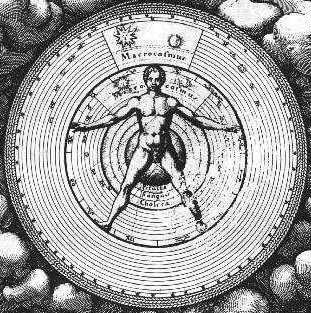Microcosm/macrocosm
Even within the body of humans the same patterns were seen. The head* was the sun-king-lion-eagle-gold of the little world of the human, the godlike part which was the seat of reason. Thus, in the microcosm of the body was figured the macrocosm of the kingdom, and of the universe itself. (Click here to read about an unusual symbol of the microcosmic kingdom*.)
This little kingdom, man
Falstaff describes the way that sack warms the blood, and
. . . makes it course from the inwards to the parts extremes. It illumineth the face, which as a beacon gives warning to all the rest of this little kingdom, man, to arm, and then the vital commoners and inland petty spirits [vital spirits, fluids] muster me all to their captain, the heart, who, great and puffed up with this retinue, doth any deed of courage . . .
(Henry IV, Part Two, 4. 3. 107-113)
In Coriolanus, Menenius calms the mutinous citizens of Rome with a jocular tale about the time "when all the body's members/Rebelled against the belly" (I. i. 97-98). The point he makes is that all parts of the body are equally important in the scheme of things, just as all levels of society are important in the smooth functioning of the body politic.
Footnotes
-
Head, heart, sun
Nothing is ever simple: in some Renaissance systems the sun was seen as corresponding to the heart.
-
The paragon of animals
The beehive, with its orderly division of roles and a single queen bee, was an ideal symbol as a microcosm of the ordered human state.
Click here to see Shakespeare's use of the image in Henry V.
